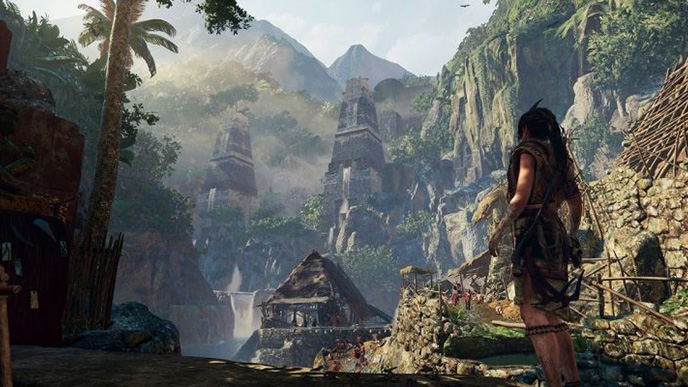
Years ago, the Mexican filmmaker Guillermo Del Toro said something that almost set me free. The director, as he confessed to a small crowd in Portland, consumes a lot of books, movies, and videogames as a creator, but resists the pressure to finish them if he just isn’t interested. “If it doesn’t engage me, I leave it. I do not do homework with my life.” As someone who is finding it ever harder not to feel burdened by the obligation of accumulating knowledge on everything related to arts and entertainment, I found it refreshing. My life would be a lot more enjoyable if there were certain things I didn’t force myself to do. For a second, I thought, maybe I could do that. How liberating it would be.
But unfortunately for me, I am a media critic, and I don’t have the luxury of not finishing things. And never has this been more painfully evident than with the time I’ve spent on Shadow of the Tomb Raider, the latest chapter in the lengthy origin story of Lara Croft. In this new adventure, Lara, in pursuit of her old nemesis Trinity, searches for a long lost Mayan city in Peru, and triggers an apocalypse in the process. In order to set things right, she has to recover the ceremonial knife that started it all, and finds herself embroiled in a conflict that is much bigger than she could have possibly ever understood.
Shadow of the Tomb Raider is for the most part competent. The production values are high, the graphics and setting are beautifully rendered, the user interface is well organized, and I encountered few technical problems (outside some shoddy facial animations). In terms of gameplay, the environmental puzzles Lara encounters as she explores ruins and comes across traps and elaborate machines are sufficiently challenging, and provide a gratifying sense of completion. Enemy encounters can be approached by either stealth or direct gunfire, although the latter could use some polish, and both could use more hand-to-hand options for close range and a dedicated crouch button. But once you get going, the game holds just enough euphoric tension to give it some momentum. The theatrics in some of Lara’s methods, particularly when she strings up an enemy with rope and drops him from a tree, are a pure dopamine high. And those moments when Lara is climbing, swinging and scaling rock walls achieve a thrilling fluidity that feels downright empowering; she is truly at her best when the obstacles in her surroundings are just another part of the jungle gym.
But despite that tactile joy, I had difficulty working up the motivation to play Shadow of the Tomb Raider, much less keep at it for the duration necessary for a review. Some adventure games have fantastic combat that I’ll slog through any amount of shitty narrative for, while others have a story that is so good it makes up for sluggish action sequences. If I’m lucky, the game I’m playing excels at both. But Shadow of the Tomb Raider seems to have neither. Amid its Far Cry-Uncharted crossover feel, I struggled to find what makes it different, special or appealing.
Part of it is that I just don’t care about Lara Croft. Despite all her adventures, she doesn’t strike me as a person who’s really lived. While the series has explored some painful moments for Lara (including one segment of Shadow of the Tomb Raider that reveals a deeply traumatic childhood backstory), never does it seem to cultivate an identity or personality I can really get my hands on. For a character whose original appeal relied so much on 3D, it’s exhausting that’s she’s still stuck in the first dimension. It feels like they’re trying too hard to give us no reason not to like her.
It’s not that I need to like Lara in order to be interested in her. But as someone with a rather colorful personality herself, Lara is boring. She is one of the most autonomous women in videogame history and somehow still manages to have all the zest of an untoasted marshmallow, permeating an odd air of fragility even as she effortlessly crawls, climbs and leaps all over her surroundings. She has no major emotional problems, she is pleasant to be around, and I suspect she doesn’t even fart. Lara Croft is the pint of gourmet vanilla bean Haagen Daaz to my half gallon of Western Family neapolitan. And I hate her for it.
As for the game’s overarching narrative content, I think much of my concerns were already addressed in my earlier piece, which I originally posted with a (perhaps unearned) tentativeness because I had not seen the final product. I didn’t necessarily expect the game to find a self awareness outside of the slim portion it’d already shown in the demos I’d played and the footage I’ve seen (although during the original reboot in 2012, their creative director was receptive when I spoke with him about some of their design decisions with Lara), but I’m still disappointed to say, in that regard, it did live up to my low expectations. The disclaimer that had prompted my article actually shows up in the opening moments of Shadow of the Tomb Raider, and encountering it a second time, my first impression remained the same.
Shadow of the Tomb Raider was created by a diverse and talented team comprised of multiple genders, backgrounds, ethnicities, religious beliefs, and personalities. Although the game is not based on actual events and represents a work of fiction, it was developed in conjunction with an historian and cultural consultants. This variety and partnership were both instrumental in crafting the world you’re about to experience.
This is a paragraph that strikes me not as a sincere expression of good intent, but rather, a deflection of anticipated criticism. Which is not to say that content disclaimers are a cop-out; the Whoopi Goldberg segment at the beginning of Warner Bros. cartoon shorts comes to mind. But while the former (which covers such irrelevant buffer details such as the team’s personalities and religious beliefs) wants to get ahead of the issue, the latter addresses and refuses to erase an atrocity. And I guess that’s my concern: the writers of Shadow of the Tomb Raider wanted to do what they wanted to do, so they found a way to justify it retroactively to cater to a culture shift within the games community. But while the development process may have included historians to ensure the accuracy of the game’s set dressing, it doesn’t appear as though they were involved to the point that it challenged any power structures within the design process itself, which omits the possibility of meaningful culture exchange. And that is evident throughout the game itself. Lara is a tourist, and it feels like it.
These days it seems like the games with the most in common are also the ones that run on for fucking ever. The past two years or so have been one big blur of Far Cry and Horizon Zero Dawn and God of War and Uncharted and Tomb Raider and whatever else, blended together in one big blur of on-rails climbing, lore-building collectibles, crafting upgrades, and skill trees with incremental performance boosters. Sometimes it’s almost astonishing how much blatant overlap there is between all these major titles, as if some things have just been accepted now as established convention and the one true way to convey certain ideas or organize a user interface. I appreciate having the ability to pick up certain concepts very quickly between games, but there’s a monotony sinking in here that no amount of smart branding and cohesive visual themes will cure.
Sometimes when you’re too worried about what other people think, you wind up never taking any risks. I think that’s why Shadow of the Tomb Raider doesn’t seem to have an identity of its own. Whether it’s hiding behind the tried-and-true formula established by all the other heavy hitters of big game design, or shaping the perfect pile of mashed potatoes into a swashbuckling heroine, the game feels too safe. I’d love to see what they’d do with a Lara Croft that was actually allowed to think and feel any of the normal reactions a person would have to their trauma. Give me a female lead who wakes up, pisses out her diaphragm and does a shot of Jager while she’s still on the toilet. Give me someone who is messy, who makes mistakes not out of a misguided and entitled sense of right and wrong, but because human beings are flawed and have complicated motivations. It’s a tall order in an atmosphere where AAA games are designed just as much by their investors as they are their writers, but in the case of Shadow of the Tomb Raider, I still wish they’d actually get their hands dirty.
Shadow of the Tomb Raider was developed by Eidos Montreal and published by Square Enix. Our review is based on the PlayStation 4 version. It is also available for Xbox One and PC.
Holly Green is the assistant editor of Paste Games and a reporter and semiprofessional photographer. She is also the author of Fry Scores: An Unofficial Guide To Video Game Grub. You can find her work at Gamasutra, Polygon, Unwinnable, and other videogame news publications.

